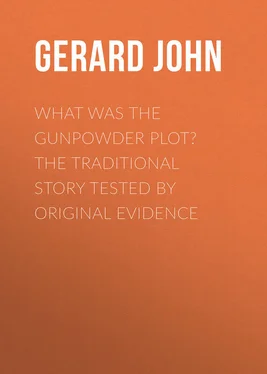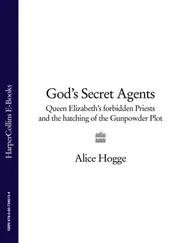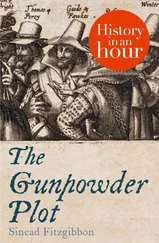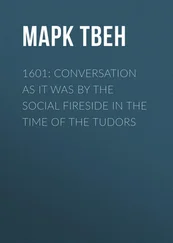John Gerard - What was the Gunpowder Plot? The Traditional Story Tested by Original Evidence
Здесь есть возможность читать онлайн «John Gerard - What was the Gunpowder Plot? The Traditional Story Tested by Original Evidence» — ознакомительный отрывок электронной книги совершенно бесплатно, а после прочтения отрывка купить полную версию. В некоторых случаях можно слушать аудио, скачать через торрент в формате fb2 и присутствует краткое содержание. Жанр: foreign_antique, foreign_prose, на английском языке. Описание произведения, (предисловие) а так же отзывы посетителей доступны на портале библиотеки ЛибКат.
- Название:What was the Gunpowder Plot? The Traditional Story Tested by Original Evidence
- Автор:
- Жанр:
- Год:неизвестен
- ISBN:нет данных
- Рейтинг книги:5 / 5. Голосов: 1
-
Избранное:Добавить в избранное
- Отзывы:
-
Ваша оценка:
- 100
- 1
- 2
- 3
- 4
- 5
What was the Gunpowder Plot? The Traditional Story Tested by Original Evidence: краткое содержание, описание и аннотация
Предлагаем к чтению аннотацию, описание, краткое содержание или предисловие (зависит от того, что написал сам автор книги «What was the Gunpowder Plot? The Traditional Story Tested by Original Evidence»). Если вы не нашли необходимую информацию о книге — напишите в комментариях, мы постараемся отыскать её.
What was the Gunpowder Plot? The Traditional Story Tested by Original Evidence — читать онлайн ознакомительный отрывок
Ниже представлен текст книги, разбитый по страницам. Система сохранения места последней прочитанной страницы, позволяет с удобством читать онлайн бесплатно книгу «What was the Gunpowder Plot? The Traditional Story Tested by Original Evidence», без необходимости каждый раз заново искать на чём Вы остановились. Поставьте закладку, и сможете в любой момент перейти на страницу, на которой закончили чтение.
Интервал:
Закладка:
How, then, did they dispose of the mass of soil dug out in making a tunnel through which barrels and hogsheads were to be conveyed? No man who has had practical experience of the unexpected quantity of earth which comes out of the most insignificant excavation, will be likely to rest satisfied with the explanation officially given, that it was sufficiently concealed by being hidden beneath the turf in the little garden adjoining. 150 150 Jardine, Gunpowder Plot , p. 48.
What, moreover, was done with the great stones that came out of the foundations? Of these there must have been on hand at least some sixty cubic feet, probably much more, and they, at any rate, can scarcely have been stowed away beneath the turf.
What, above all, of the noise made during the space of a couple of months, in assaulting a wall "very hard to beat through"? It is a matter of common observation how sound travels in the ground, and every stroke of the pick upon the stone must have been distinctly heard for more than a hundred yards all around, constituting a public nuisance. Meanwhile, not only were there people living close by on every side, but men were constantly at work right over the heads of the diggers, and only a few feet from them: yet we are required to believe that neither these nor any others had any notion that anything unusual was going on.
Neither is it easy to understand how these amateurs contrived to do so much without a catastrophe. To make a tunnel through soft earth is a very delicate operation, replete with unlooked-for difficulties. To shore up the roof and sides there must, moreover, have been required a large quantity of the "framed timber" of which Speed tells us, and the provision and importation of this must have been almost as hard to keep dark as the exportation of the earth and stones. A still more critical operation is that of meddling with the foundations of a house – especially of an old and heavy structure – which a professional craftsman would not venture upon except with extreme care, and the employment of many precautions of which these light-hearted adventurers knew nothing. Yet, recklessly breaking their way out of one building, and to a large extent into another, they appear to have occasioned neither crack nor settlement in either.
We are by no means at the end of our difficulties. According to the tale told by Faukes, 151 151 November 17th, 1605.
all the seven miners "lay in Percy's house," never showing themselves while the work was in progress. This circumstance, to say nothing of the storage of powder barrels and timber, seems to imply that the premises were spacious and commodious. We learn, however, on the unimpeachable evidence of Mrs. Whynniard's servant, 152 152 November 7th, 1605.
that the house afforded accommodation only for one person at a time, so that when Percy came there to spend the night, Faukes, who passed for his man, had to lodge out. This suggests another question. Percy's pretext for laying in so much fuel was that he meant to bring up his wife to live there. But how could this be under such conditions?
Still more serious is another problem. When the mining operations were commenced, in December, 1604, Parliament was appointed to meet on the 7th of February following, by which time, as is evident, the preparations of the conspirators could not have been completed. While they were working, however, news came that the session was to be postponed till October. This information the conspirators appear to have received quite casually before Christmas, for it is said that on the strength of it, they thought they could afford to take a holiday. 153 153 Winter says: "… We heard that the Parliament should be anew adjourned until after Michaelmas; upon which tidings we broke off both discourse and working until after Christmas" (November 23rd, 1605). Lingard writes, "When a fortnight had thus been devoted to uninterrupted labour, Faukes informed his associates that the Parliament was prorogued from the 7th of February to the 3rd of October. They immediately separated to spend the Christmas holidays at their respective homes." — History , vii. 47 (ed. 1883).
Early in January they were again at work, 154 154 Faukes, as has been said, makes the work upon the wall terminate at Candlemas. Winter ( ut sup. ) says that they brought over the powder at Candlemas, that is, after they had been some time engaged upon the wall, and found the need of the assistance of Keyes.
and they continued their operations thenceforth, without any circumstance intervening to interrupt or alarm them, of which we hear anything either from themselves or from subsequent writers. Nevertheless, it is quite certain that the Lords actually met on February 7th – that is while the mining operations were going on – and not only went through the ceremony of prorogation, but transacted some little business besides, Lord Denny being introduced and his writ of summons read. 155 155 Lord's Journals "Ao 1604(5) 2 Jac. – Memorandum quod hodierno die, septimo die Februarii, Ao Regis ñri Jacobi, viz. Angliae (etc.) 2ndo, & Scotiae 38o, in quem diem prorogatum fuerat hoc praesens parliamentum, convenere Proceres tam Spirituales quam Temporales, quorum nomina subscribuntur." Then follow twenty-nine names, including the Archbishop of Canterbury, Lords Ellesmere ( Chancellor ), Dorset ( Treasurer ), Nottingham ( Admiral ), Suffolk ( Chamberlain ), Northumberland, Cranborne (Cecil), Northampton, etc. It is noted "Lords Montagu, Petre, and Gerard [all three Catholics] were present, though they were none of the Commissioners."
It is equally incomprehensible that the miners should have known nothing of so startling an occurrence, or that knowing of it they should never have made the slightest mention thereof. It is even more difficult to explain how the Peers thus assembled, and their attendants, could have failed to remark the mine, then actually open, in premises belonging to themselves, or any suspicious features of earth, stones, timber, or barrels.
The difficulties presented by the stubborn nature of the foundation-wall proved well-nigh insuperable, but, as is observed by Father Greenway, 156 156 Narrative (Stonyhurst MSS.), fol. 44 b.
one still more grave awaited the diggers had they succeeded in making their way through. The "concavity" to be excavated within, to contain the large number of powder barrels required for their purpose, would have involved engineering work of the most hazardous kind, and heavily laden as the floor above proved to be, it must, according to all rules of calculation, have collapsed, when thus undermined. But at this juncture, when the wall had been half pierced, a circumstance occurred, not less extraordinary than others we have considered, to change the whole plan of operations.
All this time, ridiculous as is the supposition, the conspirators appear to have been ignorant of the existence of the "cellar," and to have fancied that they were working their way immediately beneath the Chamber of the Peers. 157 157 This absurd supposition is obviously implied by Faukes (November 17th, 1605), and T. Winter (November 23rd), in the only two accounts furnished by any of the conspirators wherein the episode of the mine is mentioned. In Barlow's Gunpowder Treason ( Harleian Miscellany , iii. 123) it is expressly stated that the confederates "came to the knowledge of the vault" only on the occasion now detailed. Tierney says (Dodd's Church History , iv. 45, note): "At this moment an accidental noise … first acquainted them with the existence of the cellar."
If such a circumstance be incredible, the consequences must be borne by the narrative of which it forms an essential feature. That it is incredible can hardly be questioned. The so-called "cellar," as we have seen, was a large and conspicuous room above ground. There are reasons for believing that it served habitually as a passage between the different parts of the palace. It appears certain that some of the conspirators, Percy in particular, as being one of his Majesty's pensioners, must have frequently been in the House of Lords itself, and therefore have known where it was; and clearly men of their position were able to attend there when they chose. 158 158 On the 3rd of October following, Thomas Winter was sent to be present at the ceremony of prorogation, and to watch the demeanour of the assembled peers.
Интервал:
Закладка:
Похожие книги на «What was the Gunpowder Plot? The Traditional Story Tested by Original Evidence»
Представляем Вашему вниманию похожие книги на «What was the Gunpowder Plot? The Traditional Story Tested by Original Evidence» списком для выбора. Мы отобрали схожую по названию и смыслу литературу в надежде предоставить читателям больше вариантов отыскать новые, интересные, ещё непрочитанные произведения.
Обсуждение, отзывы о книге «What was the Gunpowder Plot? The Traditional Story Tested by Original Evidence» и просто собственные мнения читателей. Оставьте ваши комментарии, напишите, что Вы думаете о произведении, его смысле или главных героях. Укажите что конкретно понравилось, а что нет, и почему Вы так считаете.












